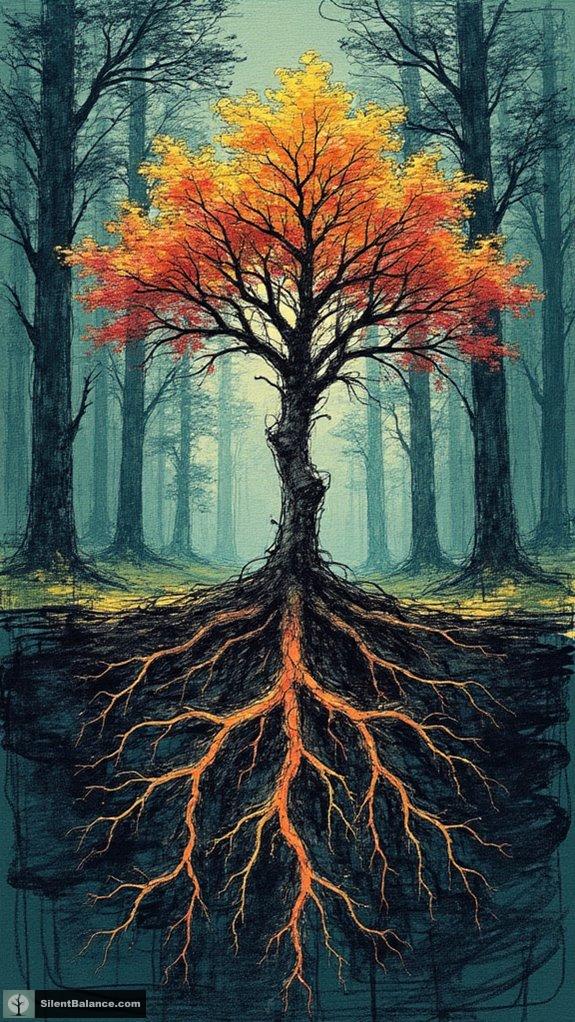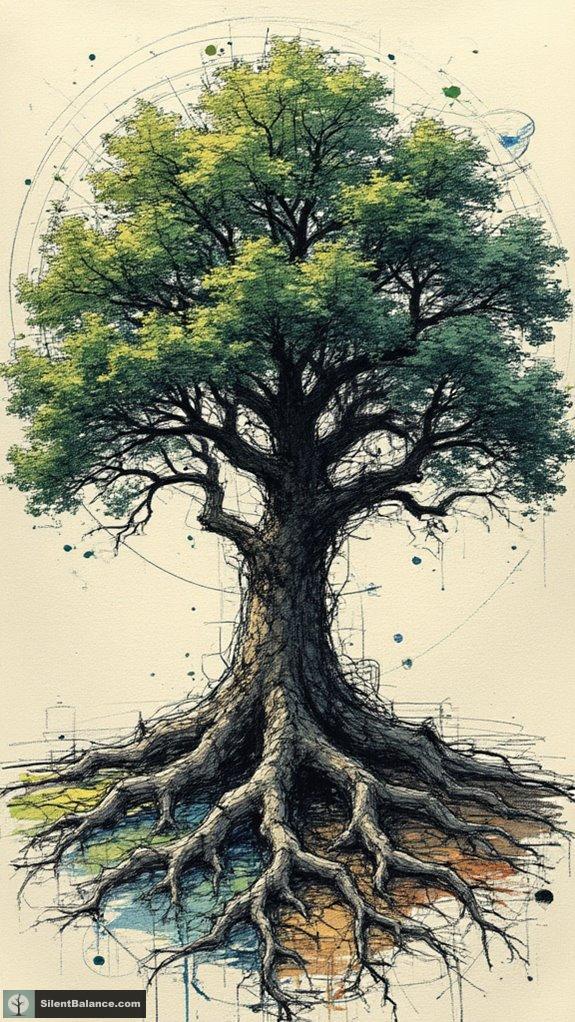Unraveling the Secrets of Plant Communication
Imagine stepping into a whispering forest, where trees engage in a silent conversation. These mystical exchanges are more than fascinating; they wield profound symbolism of trees, connecting us to the very essence of nature.
A year ago, I wandered through a lush woodland, awestruck. In every rustling leaf, I felt a heartbeat. At that moment, I realized how connected we are to the trees around us. Their stories are rich, yet largely untold.
Here at Silent Balance, we delve into these enchanting tales. There’s a profound network of cooperation and competition among plants. With technology advancing, who knows what we will learn about their silent chatter?
Future research in plant communication is ripe with possibilities. From mycorrhizal networks to understanding vibrations, we’re on the brink of enlightening discoveries. Let’s give a voice to the forests, one tree at a time!
Quick Takeaways
- Investigating how mycorrhizal networks facilitate resource sharing among diverse tree species can deepen our understanding of forest ecosystems.
- Developing AI models to translate tree signals into human language may revolutionize our comprehension of plant communication.
- Utilizing low-power sensors to capture bioelectrical signals among trees can provide insights into their health and stress levels.
- Exploring the impact of environmental changes on tree communication systems is crucial for conservation efforts and ecosystem stability.
- Collaborating across disciplines, such as ecologists and linguists, can yield innovative approaches to studying plant behavior and communication methods.
Examining the Role of Mother Trees in Communication Networks

When you think about forests, do you ever wonder how the trees chat with each other?
Enter the mighty Mother Trees—the rock stars of the woodlands. These giants stand tall, not just in height but in their underground connections! They team up with mycorrhizal fungi, creating an incredible “Wood Wide Web” that hooks multiple trees together.
Picture this: with roots spreading wide and deep, Mother Trees share carbon, nutrients, and water with young saplings, nurturing them until they’re ready to shine. Notably, Mother Trees are pivotal to forest health and communication, as they facilitate these vital exchanges among diverse species. This unique relationship highlights the importance of mycorrhizal networks in supporting the broader forest ecosystem.
Ever heard of kin recognition? Yeah, these trees know their offspring, prioritizing them in resource-sharing.
It all adds up to a vibrant, cooperative forest, where communication isn’t just a whisper; it’s a chorus, making every tree a part of the community orchestra!
Investigating Various Types of Messages in Tree Communication

Have you ever wondered just how trees “talk” to each other?
It’s wild! They use volatile organic compounds, or VOCs, to send out vibes about their health or warn neighbors of herbivore attacks. Some studies suggest that this chemical signaling can even influence the growth patterns of other trees nearby.
Ever notice a tree near another? Their chats get deeper if they’re relatives!
But that’s not all. Beneath the surface, mycorrhizal networks act like a tree’s underground social media, sharing nutrients and stress signals. MNs facilitate communication between trees, allowing them to exchange vital resources and defense signals.
Trees even communicate with electric pulses, almost like they’re texting each other about danger.
And let’s not forget the sounds they might make—some roots crackle like they’re jamming to a beat!
In the grand symphony of the forest, tree communication is surprisingly complex and endlessly fascinating! Curious to learn more?
Cooperation vs. Competition in Tree Interactions

Tree communication doesn’t just stop at sharing warnings about pests or exchanging nutrients—it’s a wild mix of cooperation and competition that shapes forest dynamics.
You’ve got trees working together, sharing resources like nutrients from big ol’ “mother trees” to their struggling neighbors, which looks pretty altruistic, right? However, researchers like Torgny Näsholm emphasize that while trees engage with numerous fungal species, the idea of direct nutrient exchange remains controversial, as compelling evidence for such direct nutrient exchange is lacking.
But don’t forget, competition’s lurking too, with trees vying for light and water, often leaving seedlings in the dust.
It’s all about balance, baby! While some studies flaunt the collaborative spirit, others poke holes in the idea of generous nutrient-sharing.
Understanding Cultural Symbolism in Tree Communication

While you might associate trees primarily with nature and growth, they also represent deep cultural significance across communities worldwide.
Ever thought about how trees symbolize life, wisdom, or even spiritual guidance? In many Indigenous cultures, trees are seen as ancestors or protectors, embodying kinship through the “wood wide web.” These living beings play a role in rituals, weaving their roots into community identity. Moreover, trees regulate climate and water cycles, essential for maintaining ecological balance and supporting life within these communities.
Trees symbolize life and wisdom, serving as ancestral protectors and weaving kinship through the “wood wide web.”
And it doesn’t stop there! From the Tree of Life symbolizing our connection to the cosmos to oaks representing strength, trees pack a cultural punch. They foster our connection to the environment and heritage, illustrating a deeper commitment to stewardship.
Advancements in Communication Technology for Tree Studies

In a world where technology and nature often seem at odds, advancements in communication technology are bridging that gap, and it’s pretty exciting!
Imagine using AI to decode trees’ chemical chatter. We’re seriously talking about algorithms that reveal patterns in their signals. How cool is that?
With low-power sensors capturing bioelectrical signals, trees can alert each other about the latest environmental happenings, like impending solar eclipses. Isn’t nature clever?
Plus, with 3D models and digital twins, we can even simulate a tree’s health over time. This technology could help us better understand how trees use chemical signals to communicate with each other.
These innovative tools not only revolutionize our understanding of tree communication but also empower conservation efforts. Isn’t it time we embrace these tech-savvy trees?
Watching them talk might just change how we think about forests forever!
Future Research Directions in Tree Communication Science

As scientists gear up to dive deeper into tree communication, you’re in for a thrilling ride through uncharted territory!
There’s so much to explore, and here are four future research directions that’ll really ignite your curiosity:
- Investigate the wide range of signaling molecules in mycorrhizal networks to grasp belowground conversations.
- Examine how tree communication influences forest resilience against environmental stress and herbivory.
- Explore the complex balance of competition and cooperation among tree roots and fungi.
- Probe into the evolutionary side of communication to uncover how co-adaptations shape tree interactions.
You’ve got the chance to be part of an exciting journey in understanding how trees talk, thrive, and face challenges together!
Isn’t that something worth getting inked about?
Scientific Studies on Tree Communication

Alright, let’s get into the fascinating world of tree communication!
Have you ever wondered how trees talk to each other beneath the surface? Through a wild blend of chemical signaling, interconnected root networks, and even acoustic communication techniques, trees pull off a remarkable conversation that keeps their forest communities thriving.
Chemical Signaling Mechanisms
While you might think of trees as quiet giants standing tall in the forest, they’re actually buzzing with chemical chatter that would put the most talkative friend to shame!
These botanical beings engage in a wild conversation through chemical signals, keeping each other informed and alert. Here’s how they do it:
- Trees emit volatile organic compounds (VOCs) that share their stress levels.
- Chemical exudates help neighboring plants get in on the action below ground.
- Mycorrhizal networks transport hormonal signals, like a fungal highway.
- They even send out electrical impulses, acting like nature’s slow-motion text messages!
Root Network Interactions
Root networks in forests aren’t just a tangled mess of roots underground; they’re a vibrant community operating like a bustling city.
These networks connect fine root tips to microscopic fungi, creating a symbiotic relationship where trees share resources, not just compete. Ever heard of carbon transfer? Injured trees send vital nutrients to their neighbors through these networks—how cool is that?
Plus, when one tree faces a threat, it signals its pals to prepare defenses. Talk about teamwork!
But here’s the kicker: without these mycorrhizal connections, the whole operation could crumble.
Acoustic Communication Techniques
When it comes to tree communication, you might be surprised to learn that these majestic giants can actually talk—just not in the way we do.
Trees send out acoustic signals, using low-frequency sounds to share essential info.
Here’s what you should know about their chatter:
- Old Growth Sitka Spruce trees hum within 20-90 Hz, revealing their unique vibes.
- Roots create sounds, indicating a hidden language among plants.
- Tree crickets take advantage of these sounds, amplifying their own calls with leaves.
- Acoustic signals are important for plant health, reflecting their stress levels.
Besides just growing tall, trees vibe in their own funky way! Isn’t nature’s communication simply wild?
Future Directions in Tree Communication Studies

As researchers dive deeper into the fascinating world of tree communication, it becomes clear that the future holds exciting possibilities for understanding how these majestic beings interact.
Ever pondered how trees share resources and information through underground fungal networks? It’s wild!
With AI modeling our findings, we might predict how logging alters these channels. Plus, envision translating tree signals into human language—talk about a breakthrough!
Let’s not forget the bioelectrical chatter, with spruce trees syncing up before an eclipse. How cool is that?
Sure, there are debates around whether this is true communication, but isn’t that the point? As we explore these paths, we open up discussions that could redefine our view of trees—maybe even give them the recognition they deserve.
Questions and Answers
How Do Trees Communicate Distress Signals to Other Plants?
Trees communicate distress signals like pros! When one’s under attack, it sends out chemical distress calls through underground fungal networks—think of it as their own private hotline.
They also drop volatile organic compounds (VOCs) into the air, warning nearby plants—like giving them a heads-up to brace for impact.
What Role Do Fungal Networks Play in Tree Communication?
Fungal networks are like the underground VIP connections for trees, allowing them to communicate and share resources.
Envision trees sending out distress signals when they’re hurt; these networks transmit warnings, helping neighbors survive. They transfer nutrients, especially from mother trees, to younger kin, strengthening the whole grove.
Can you visualize the resilience of a forest thriving together? It’s a wild ecosystem of cooperation that just keeps growing—literally!
How do you feel about nature’s hidden connections?
Can Trees Recognize Individual Neighbors in Their Networks?
envision wandering through a vibrant forest, where each tree isn’t just a silent sentinel, but a savvy neighbor, recognizing its companions.
Can you visualize those roots, reaching out like old pals sharing secrets? Absolutely! Trees can identify individual neighbors, using their unique chemical signals and mycorrhizal networks, just like a tattoo artist knows their client’s style.
How Do Environmental Changes Affect Tree Communication Methods?
So, you’re curious about how environmental changes shake things up for tree communication?
Well, when drought hits, trees don’t just shrug it off; they signal to their buddies, helping each other conserve water. Isn’t that wild?
And those older trees?
They send bioelectrical vibes during solar eclipses, warning younger ones about upcoming changes.
It’s like nature’s version of a group chat, ensuring everyone stays in the know. Talk about teamwork in the forest!
What Impact Does Urbanization Have on Tree Communication Systems?
Urbanization totally messes with tree communication systems, doesn’t it? As concrete takes over, trees get isolated, losing crucial connections to their buddies underground.
Compacted soil? You bet that hampers root growth and signaling! Plus, pollutants can seriously damage their ability to chat.
It’s like throwing a wrench in a delicate ink machine! So, if we wanna keep trees talking, we need to step up our game and manage these urban jungles smarter, don’t you think?
Summary
In wrapping this up, isn’t it fascinating that trees can communicate over distances of up to 50 meters? Who knew they had such a chatty nature? As we dive deeper into their secret conversations, exploring everything from mother trees to their quirky slang, we’re opening up a whole new world of understanding. So, what’s your take on this leafy gossip? Let’s keep our ears to the ground, or should I say, roots, and see where this research leads us!
References
- https://phys.org/news/2025-04-century-mystery-communication-stress-negative.html
- https://www.nesta.org.uk/feature/future-signals-2025/translating-the-hidden-language-of-plants/
- https://vivent-biosignals.com/2025/01/09/leavesdropping-translating-the-hidden-language-of-plants/
- https://ag.purdue.edu/news/2024/03/decoding-the-plant-worlds-complex-biochemical-communication-networks.html
- https://sourland.org/plant-behavior-january-2025/
- https://mothertreeproject.org/about-mother-trees/
- https://emergencemagazine.org/conversation/finding-the-mother-tree/
- https://pmc.ncbi.nlm.nih.gov/articles/PMC4497361/
- https://e360.yale.edu/features/exploring_how_and_why_trees_talk_to_each_other
- https://nph.onlinelibrary.wiley.com/doi/10.1111/nph.18935
- https://link.springer.com/article/10.1007/s40725-022-00177-8
- https://www.smithsonianmag.com/science-nature/the-whispering-trees-180968084/
- https://academics.lmu.edu/media/lmuacademics/cures/urbanecolab/module10/Ecologist Says Trees Talk to Each Other in a Language We Can Learn.pdf
- https://www.interesjournals.org/articles/plant-communication-do-trees-really-talk-to-each-other.pdf
- https://www.mycostories.com/post/the-wood-wide-web-science-debunks-the-myth-of-tree-communication
- https://www.lemonde.fr/en/science/article/2023/02/24/researchers-challenge-idea-of-underground-tree-communication-in-forests_6017059_10.html
- https://www.culturalsurvival.org/news/importance-our-relatives-forests-and-trees
- https://www.americanforests.org/article/people-and-trees-an-intimate-connection/
- https://openscholar.uga.edu/record/22160/files/Cultural Aspects of Trees 11-02.pdf
- https://pmc.ncbi.nlm.nih.gov/articles/PMC9875087/
- Bonsai Placement Benefits for Room Harmony - November 8, 2025
- Why Use Air Layering to Propagate Bonsai Trees? - November 8, 2025
- 15 Stunning Acorn Wood Wall Art Ideas - November 8, 2025

